Bayesian Optimized of CNN-M-LSTM for Thermal Comfort Prediction and Load Forecasting in Commercial Buildings
Abstract
1. Introduction
- ANN: A classic feedforward neural network architecture [11].
- LSTM: A type of recurrent neural network capable of learning long-term dependencies [14].
- CNN: A deep learning architecture particularly effective for processing grid-like data, including time series data, which can be represented as 1D grid [15].
- Bi-LSTM: An LSTM variant that processes sequences in forward and backward directions [16].
- CNN-Bi-M-LSTM: A hybrid model combining CNNs with bidirectional multivariate LSTMs [16].
- CNN-M-LSTM: A hybrid model akin to our proposed architecture but without hyperparameter fine-tuning [15].
- M-LSTM: An LSTM variant designed to handle multiple input variables simultaneously [15].
2. Research Gap
- The proposed model optimizes indoor temperatures to enhance occupant well-being while reducing energy use and protecting building loads during peak hours. It uses an adaptive thermal comfort framework that adjusts the indoor environment in real-time based on ambient temperature. This data, combined with energy consumption and timestamps, feeds into a CNN-M-LSTM architecture for smarter climate control.
- The CNN module is tailored to efficiently reduce dimensionality and extract critical spatial features from the input data, isolating patterns related to temperature, energy consumption, and temporal markers. Meanwhile, the M-LSTM network is specifically designed to model long-term temporal dependencies and capture trends across historical sequences. Together, this integrated architecture enables precise forecasting of future HVAC loads and indoor temperatures, leveraging the synergistic extraction of spatial and temporal features for enhanced predictive performance.
- The proposed model uses Bayesian theory to fine-tune hyperparameters based on data characteristics. We tested it on commercial buildings in Jacksonville, Florida; Berkeley, California; and Hawthorn, Victoria. Since hotter regions (Florida, California) have higher energy use, we evaluated how well the model improves efficiency. Hawthorn’s unpredictable climate helped test its adaptability to rapid weather shifts and seasonal changes. These real-world conditions ensure the model works across different climates and building types.
3. Thermal Comfort Adaptive Model
4. Methodology
4.1. Data Collection and Preprocessing
4.2. Bayesian Optimization
4.3. Model Architecture
4.4. Benchmark Model
4.4.1. BO ANN
4.4.2. BO CNN
4.4.3. BO LSTM
4.4.4. BO M-LSTM
4.4.5. BO Bi-LSTM
4.4.6. BO CNN-Bi-M-LSTM
4.5. Model and Systematic Evaluation
5. Results and Discussion
6. Conclusions
- In Dataset S1, the MAPE value of BO CNN-M-LSTM is 0.1163, which higher than that of BO ANN by 10%. The NRMSE of BO CNN-M-LSTM and BO Bi-LSTM is 0.0322 and 0.0388, respectively. The score of BO CNN-M-LSTM is the highest at 0.8676, indicating a strong correlation between the predicted and actual energy consumption.
- In Dataset S2, the NRMSE value of BO CNN-M-LSTM is 0.0385, which is lower than that of BO ANN by 12%. This metric indicated that the proposed model exhibits a slight increase in error variance. The MAPE of BO CNN-M-LSTM and BO CNN-Bi-M-LSTM is 0.1939 and 0.1946, respectively. Furthermore, the score of BO CNN-M-LSTM is the highest at 0.7805. This finding highlights that BO CNN-M-LSTM can produce precise energy consumption predictions, but might exhibit error variance. Hence, to improve the NRMSE metric of the proposed model, the future work can increase the training iterations.
- In Dataset S3, the MAPE value of BO CNN-M-LSTM is 0.049, which is higher than that of BO M-LSTM by 1%. The NRMSE of BO CNN-M-LSTM is 0.0166, and that of BO Bi-LSTM is 0.0170. The score of BO CNN-M-LSTM is the highest at 0.9896. This finding shows a strong correlation between the predicted and actual energy consumption.
- In Dataset S4, the NRMSE value of BO CNN-M-LSTM is 0.0370, which is better than BO M-LSTM by 3%. The MAPE of BO CNN-M-LSTM is 0.0311, and that of BO Bi-LSTM is 0.0313. The score of BO CNN-M-LSTM is the highest at 0.9872. This result indicates a proportional relationship between the predicted and actual energy consumption.
Author Contributions
Funding
Institutional Review Board Statement
Informed Consent Statement
Data Availability Statement
Acknowledgments
Conflicts of Interest
Abbreviations
| SVM | Supervised Vector Machine |
| ANN | Artificial Neural Network |
| DDPG | Deep Deterministic Policy Gradient |
| CNN | Convolutional Neural Network |
| LSTM | Long Short-Term Memory |
| Bi-LSTM | Bidirectional Long Short-Term Memory |
| AE-DDPG | Autoencoder-Deep Deterministic Policy Gradient |
| ED-LSTM with MP | Encoder-Decoder LSTM with Multi-Layer Perceptron |
| ED-LSTM with SMP | Encoder-Decoder LSTM with Shared Multi-Layer Perceptron |
References
- International Energy Agency. Buildings-Energy System; IEA: Paris, France, 11 July 2023; Available online: https://www.iea.org/energy-system/buildings (accessed on 3 February 2025).
- U.S. Energy Information Administration. Consumption & Efficiency—U.S. Energy Information Administration (EIA). December 2022. Available online: https://www.eia.gov/consumption/commercial/data/2018/pdf/CBECS%202018%20CE%20Release%202%20Flipbook.pdf (accessed on 3 February 2025).
- Tejjy Incorporation. How HVAC System Works: Basic Functionality & Types; Tejjy Inc.: Rockville, MD, USA, 2024; Available online: https://www.tejjy.com/hvac-system-work/ (accessed on 9 December 2024).
- Jurjevic, R.; Zakula, T. Demand Response in Buildings: A Comprehensive Overview of Current Trends, Approaches, and Strategies. Buildings 2023, 13, 2663. [Google Scholar] [CrossRef]
- Agouzoul, A.; Simeu, E. Predictive Control Method for Comfort and Thermal Energy Enhancement in Buildings. In Proceedings of the 2024 International Conference on Computer-Aided Design (ICCAD), Paris, France, 15–17 May 2024. [Google Scholar] [CrossRef]
- Wang, H.; Wang, S.; Tang, R. Development of grid-responsive buildings: Opportunities, challenges, capabilities and applications of HVAC systems in non-residential buildings in providing ancillary services by fast demand responses to smart grids. Appl. Energy 2019, 250, 697–712. [Google Scholar] [CrossRef]
- Goodman, D.; Chen, J.; Razban, A.; Li, J. Identification of Key Parameters Affecting Energy Consumption of an Air Handling Unit. In Proceedings of the ASME 2016 International Mechanical Engineering Congress and Exposition (IMECE2016), Phoenix, AZ, USA, 11–17 November 2016. [Google Scholar] [CrossRef]
- Bengea, S.C.; Kelman, A.D.; Borrelli, F.; Taylor, R.; Narayanan, S. Implementation of model predictive control for an HVAC system in a mid-size commercial building. HVAC&R Res. 2014, 20, 121–135. [Google Scholar] [CrossRef]
- Zheng, P.; Wu, H.; Liu, Y.; Ding, Y.; Yang, L. Thermal Comfort in Temporary Buildings: A Review. Buildings 2022, 221, 109262. [Google Scholar] [CrossRef]
- Wang, H.; Mai, D.; Li, Q.; Ding, Z. Evaluating Machine Learning Models for HVAC Demand Response: The Impact of Prediction Accuracy on Model Predictive Control Performance. Buildings 2024, 14, 2212. [Google Scholar] [CrossRef]
- Liu, T.; Xu, C.; Guo, Y.; Chen, H. A novel deep reinforcement learning based methodology for short-term HVAC system energy consumption prediction. Int. J. Refrig. 2019, 107, 39–51. [Google Scholar] [CrossRef]
- Mohan, D.P.; Subathra, M. A comprehensive review of various machine learning techniques used in load forecasting. Recent Adv. Electr. Electron. Eng. 2022, 16, 197–210. [Google Scholar] [CrossRef]
- Liu, J.; Zhai, Z.; Zhang, Y.; Wang, Y.; Ding, Y. Comparison of energy consumption pre-diction models for air conditioning at different time scales for large public buildings. J. Build. Eng. 2024, 96, 110423. [Google Scholar] [CrossRef]
- Lara-Benítez, P.; Carranza-García, M.; Riquelme, J.C. An Experimental Review on Deep Learning Architectures for Time Series Forecasting. Int. J. Neural Syst. 2021, 31, 2130001. [Google Scholar] [CrossRef]
- Agga, F.A.; Abbou, S.A.; Houm, Y.E.; Labbadi, M. Short-Term Load Forecasting Based on CNN and LSTM Deep Neural Networks. IFAC-PapersOnLine 2022, 55, 777–781. [Google Scholar] [CrossRef]
- Bohara, B.; Fernandez, R.; Gollapudi, V.; Li, X. Short-Term Aggregated Residential Load Forecasting using BiLSTM and CNN-BiLSTM. In Proceedings of the 2022 International Conference on Innovation and Intelligence for Informatics, Computing, and Technologies (3ICT), Sakheer, Bahrain, 20–21 November 2022. [Google Scholar] [CrossRef]
- Li, H.; Dai, Y.; Liu, X.; Zhang, T.; Zhang, J.; Liu, X. Feature extraction and an interpretable hierarchical model for annual hourly electricity consumption profile of commercial buildings in China. Energy Convers. Manag. 2023, 291, 117244. [Google Scholar] [CrossRef]
- Reveshti, A.M.; Khosravirad, E.; Rouzbahani, A.K.; Fariman, S.K.; Najafi, H.; Peivan-dizadeh, A. Energy consumption prediction in an office building by examining occupancy rates and weather parameters using the moving average method and artificial neural network. Heliyon 2024, 10, e25307. [Google Scholar] [CrossRef]
- Afroz, Z.; Goldsworthy, M.; White, S.D. Energy flexibility of commercial buildings for demand response applications in Australia. Energy Build. 2023, 300, 113533. [Google Scholar] [CrossRef]
- Mayer, P.; Meyer, W.; Nussbaum, R. Performance of Demand Side Management for Building HVAC Systems. In Proceedings of the 2009 IEEE Power and Energy Society General Meeting, Calgary, AB, Canada, 26–30 July 2009; pp. 1–6. [Google Scholar]
- Kharseh, M.; Altorkmany, L.; Al-Khawaj, M.; Hassani, F. Warming impact on energy use of HVAC system in buildings of different thermal qualities and in different climates. Energy Convers. Manag. 2014, 81, 106–111. [Google Scholar] [CrossRef]
- Zhao, Q.; Lian, Z.; Lai, D. Thermal comfort models and their developments: A review. Energy Built Environ. 2021, 2, 21–33. [Google Scholar] [CrossRef]
- de Vet, E.; Head, L. Everyday weather-ways: Negotiating the temporalities of home and work in Melbourne, Australia. Geoforum 2020, 108, 267–274. [Google Scholar] [CrossRef]
- de Dear, R.; Brager, G.S. Developing an Adaptive Model of Thermal Comfort and Preference. Escholarship. 2017. Available online: https://escholarship.org/uc/item/4qq2p9c6 (accessed on 12 February 2025).
- Yang, L.; Yan, H.; Lam, J.C. Thermal comfort and building energy consumption implica-tions—A review. Appl. Energy 2014, 115, 164–173. [Google Scholar] [CrossRef]
- Yao, R.; Zhang, S.; Du, C.; Schweiker, M.; Hodder, S.; Olesen, B.W.; Toftum, J.; d’Ambrosio, F.R.; Gebhardt, H.; Zhou, S.; et al. Evolution and performance analysis of adaptive thermal comfort models—A comprehensive literature review. Build. Environ. 2022, 217, 109020. [Google Scholar] [CrossRef]
- ANSI/ASHRAE Standard 55-2020; Thermal Environmental Conditions for Human Occupancy. ASHRAE: Atlanta, GA, USA, 2020.
- Alibrahim, H.; Ludwig, S.A. Hyperparameter Optimization: Comparing Genetic Algorithm against Grid Search and Bayesian Optimization. In Proceedings of the 2021 IEEE Congress on Evolutionary Computation (CEC), Kraków, Poland, 28 June–1 July 2021; pp. 1551–1559. [Google Scholar] [CrossRef]
- Wu, J.; Chen, X.-Y.; Zhang, H.; Xiong, L.-D.; Lei, H.; Deng, S.-H. Hyperparameter Optimization for Machine Learning Models Based on Bayesian Optimization. J. Electron. Sci. Technol. 2019, 17, 26–40. [Google Scholar]
- Cho, H.; Kim, Y.; Lee, E.; Choi, D.; Lee, Y.; Rhee, W. Basic Enhancement Strategies When Using Bayesian Optimization for Hyperpa-rameter Tuning of Deep Neural Networks. IEEE Access 2020, 8, 52588–52608. [Google Scholar] [CrossRef]
- Klein, A.; Falkner, S.; Bartels, S.; Hennig, P.; Hutter, F. Fast Bayesian Optimization of Machine Learning Hyperparameters on Large Da-tasets. In Proceedings of the 20th International Conference on Artificial Intelligence and Statistics, Fort Lauderdale, FL, USA, 20–22 April 2017; pp. 528–536. Available online: https://proceedings.mlr.press/v54/klein17a.html (accessed on 12 February 2025).
- Zulfiqar, M.; Gamage, K.A.A.; Kamran, M.; Rasheed, M.B. Hyperparameter Optimization of Bayesian Neural Network Using Bayesian Optimization and Intelligent Feature Engineering for Load Forecasting. Sensors 2022, 22, 4446. [Google Scholar] [CrossRef] [PubMed]
- Aloysius, N.; Geetha, M. A review on deep convolutional neural networks. In Proceedings of the 2017 International Conference on Communication and Signal Processing (ICCSP), Chennai, India, 6–8 April 2017; pp. 588–592. [Google Scholar] [CrossRef]
- Hao, W.; Yizhou, W.; Yaqin, L.; Zhili, S. The Role of Activation Function in CNN. In Proceedings of the 2020 2nd International Con-ference on Information Technology and Computer Application (ITCA), Guangzhou, China, 18–20 December 2020; pp. 429–432. [Google Scholar] [CrossRef]
- Tomar, A.; Patidar, H. Analysis of Activation Function in the Convolution Neural Network Model (Best Activation Function Sigmoid or Tanh). Comput. Res. Dev. 2020, 20, 61–65. [Google Scholar]
- Mastromichalakis, S. ALReLU: A Different Approach on Leaky ReLU Activation Function to Improve Neural Networks Performance. arXiv 2020, arXiv:2012.07564. [Google Scholar]
- Alhussein, M.; Aurangzeb, K.; Haider, S.I. Hybrid CNN-LSTM Model for Short-Term Individual Household Load Forecasting. IEEE Access 2020, 8, 180544–180557. [Google Scholar] [CrossRef]
- Guo, X.; Zhao, Q.; Zheng, D.; Ning, Y.; Gao, Y. A Short-Term Load Forecasting Model of Multi-Scale CNN-LSTM Hybrid Neural Network Considering the Real-Time Electricity Price. Energy Rep. 2020, 6 (Suppl. 9), 1046–1053. [Google Scholar] [CrossRef]
- Dinh, T.N.; Thirunavukkarasu, G.S.; Seyedmahmoudian, M.; Mekhilef, S.; Stojcevski, A. Ro-bust-mv-M-LSTM-CI: Robust Energy Consumption Forecasting in Commercial Buildings during the COVID-19 Pandemic. Sustainability 2024, 16, 6699. [Google Scholar] [CrossRef]
- Garcia, C.I.; Grasso, F.; Luchetta, A.; Piccirilli, M.C.; Paolucci, L.; Talluri, G. A Comparison of Power Quality Disturbance Detection and Classification Methods Using CNN, LSTM and CNN-LSTM. Appl. Sci. 2020, 10, 6755. [Google Scholar] [CrossRef]
- Sherstinsky, A. Fundamentals of Recurrent Neural Network (RNN) and Long Short-Term Memory (LSTM) Network. Phys. D Nonlinear Phenom. 2020, 404, 132306. [Google Scholar] [CrossRef]
- Nichiforov, C.; Stamatescu, G.; Stamatescu, I.; Făgărăşan, I. Evaluation of Sequence-Learning Models for Large-Commercial-Building Load Forecasting. Information 2019, 10, 189. [Google Scholar] [CrossRef]
- Jing, Z.; Cai, M.; Pipattanasomporn, M.; Rahman, S.; Kothandaraman, R.; Malekpour, A.; Paaso, E.A.; Bahramirad, S. Commercial Building Load Forecasts with Artificial Neural Network. In Proceedings of the 2019 IEEE Power & Energy Society Innovative Smart Grid Technologies Conference (ISGT), Washington, DC, USA, 18–21 February 2019; pp. 1–5. [Google Scholar] [CrossRef]
- Vaisnav, A.; Ashok, S.; Vinaykumar, S.; Thilagavathy, R. FPGA Implementation and Comparison of Sigmoid and Hyperbolic Tangent Activation Functions in an Artificial Neural Network. In Proceedings of the 2022 International Conference on Electrical, Computer and Energy Technologies (ICECET), Prague, Czech Republic, 20–22 July 2022; pp. 1–4. [Google Scholar] [CrossRef]
- Bircanoğlu, C.; Arıca, N. A Comparison of Activation Functions in Artificial Neural Networks. In Proceedings of the 2018 26th Signal Processing and Communications Applications Conference (SIU), Izmir, Turkey, 2–5 May 2018; pp. 1–4. [Google Scholar] [CrossRef]
- Cai, C.; Tao, Y.; Zhu, T.; Deng, Z. Short-term load forecasting based on deep learning bidirectional LSTM neural network. Appl. Sci. 2021, 11, 8129. [Google Scholar] [CrossRef]
- Piotrowski, P.; Rutyna, I.; Baczyński, D.; Kopyt, M. Evaluation Metrics for Wind Power Forecasts: A Comprehensive Review and Statistical Analysis of Errors. Energies 2022, 15, 9657. [Google Scholar] [CrossRef]

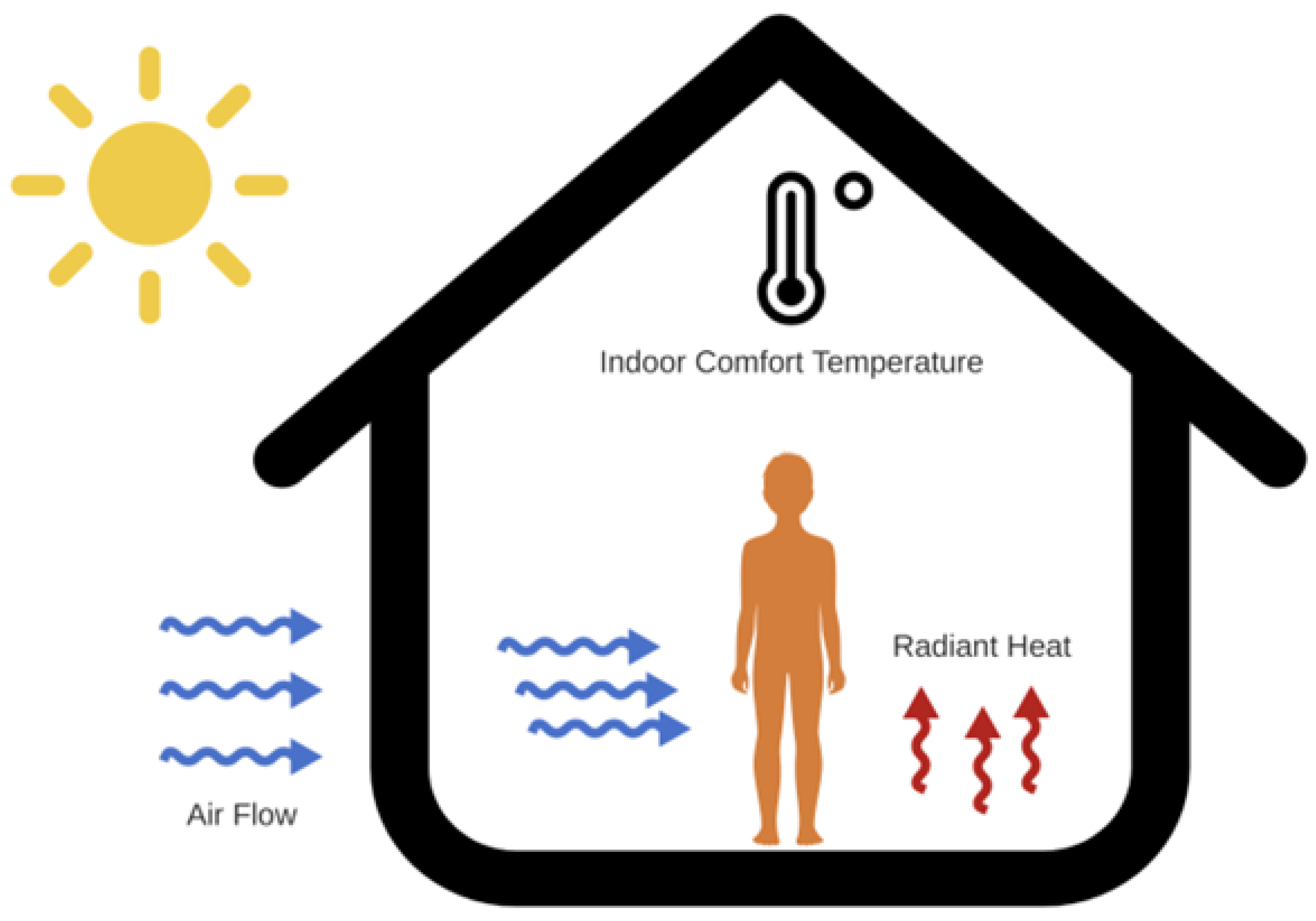
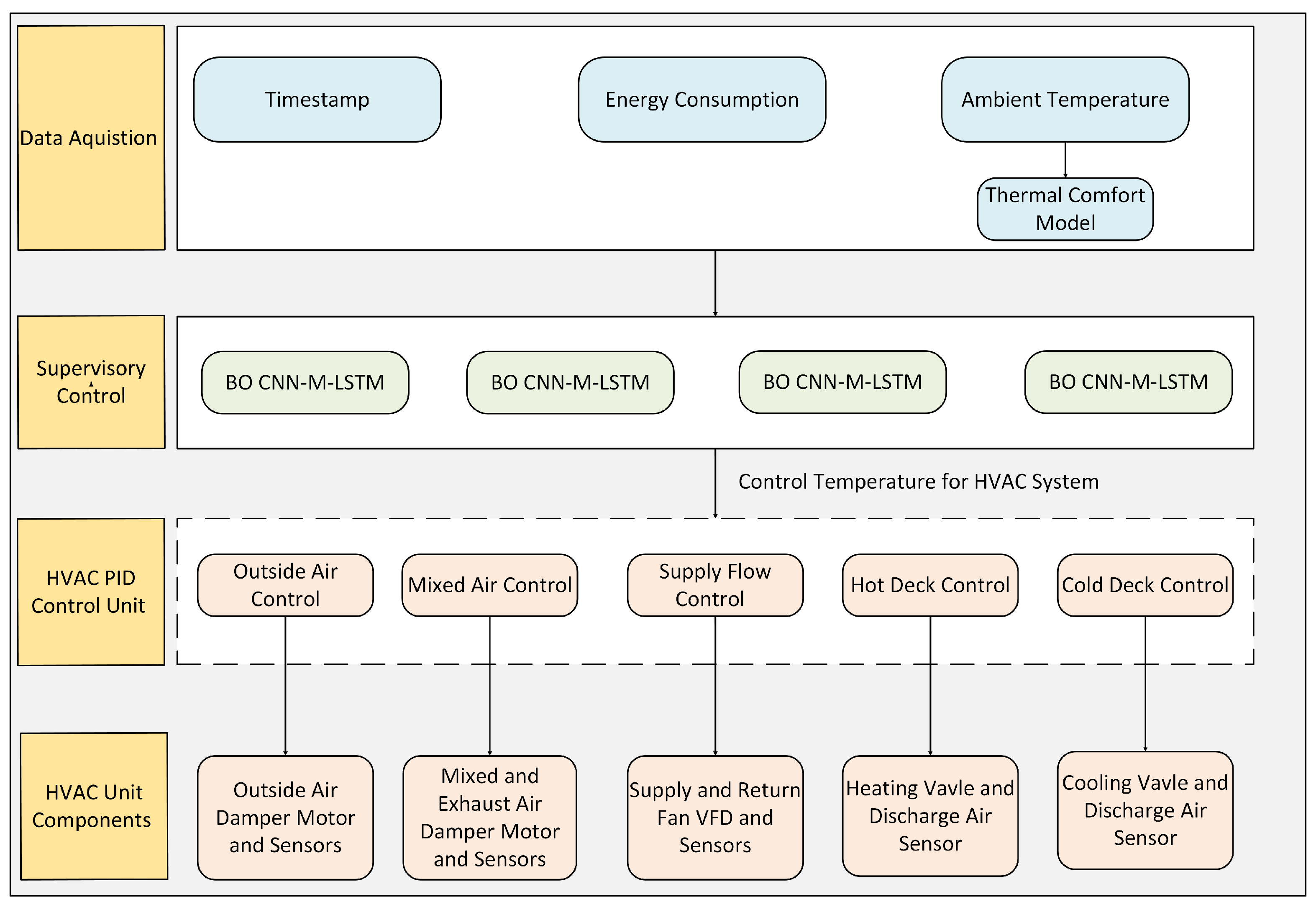
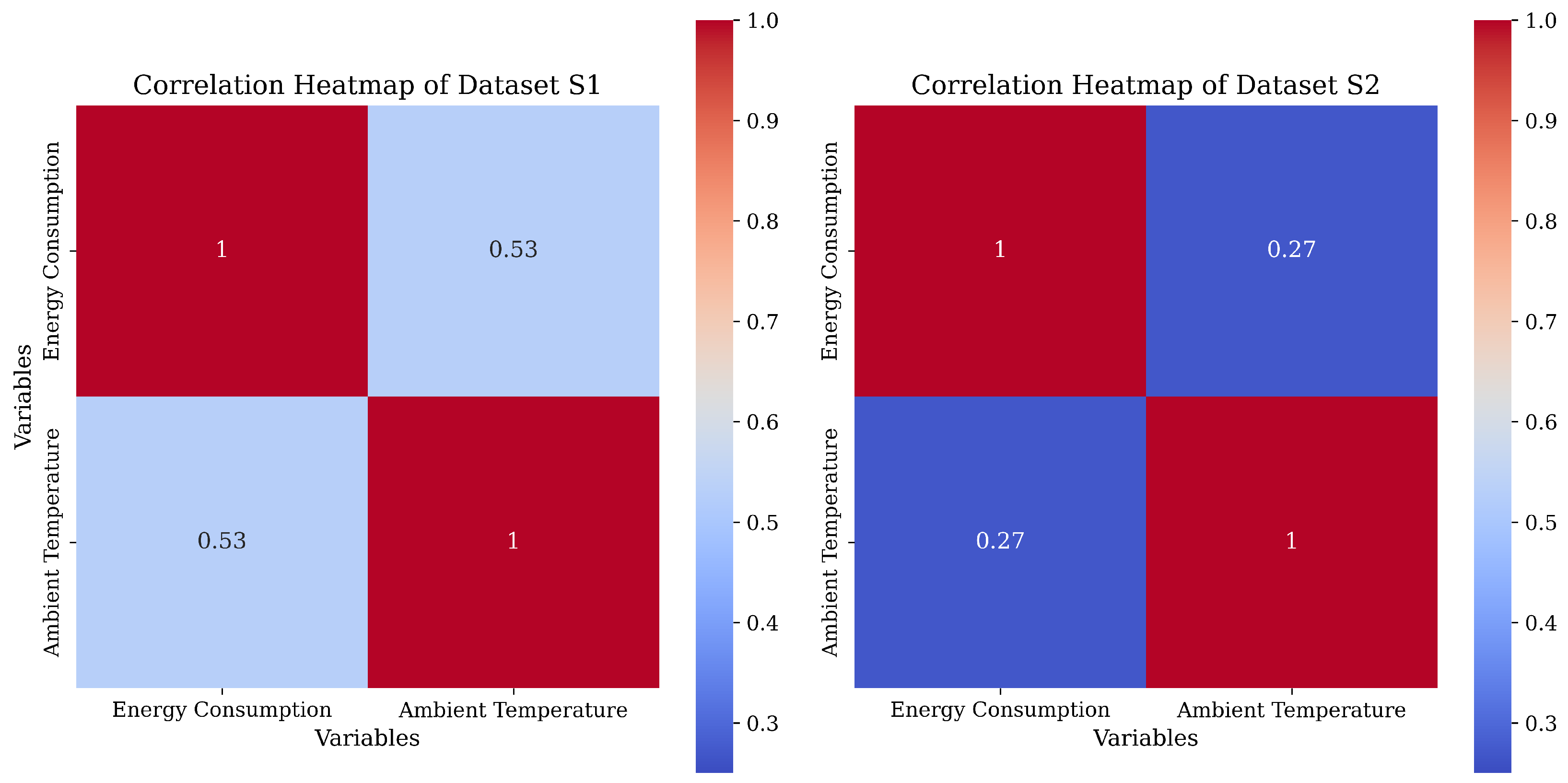

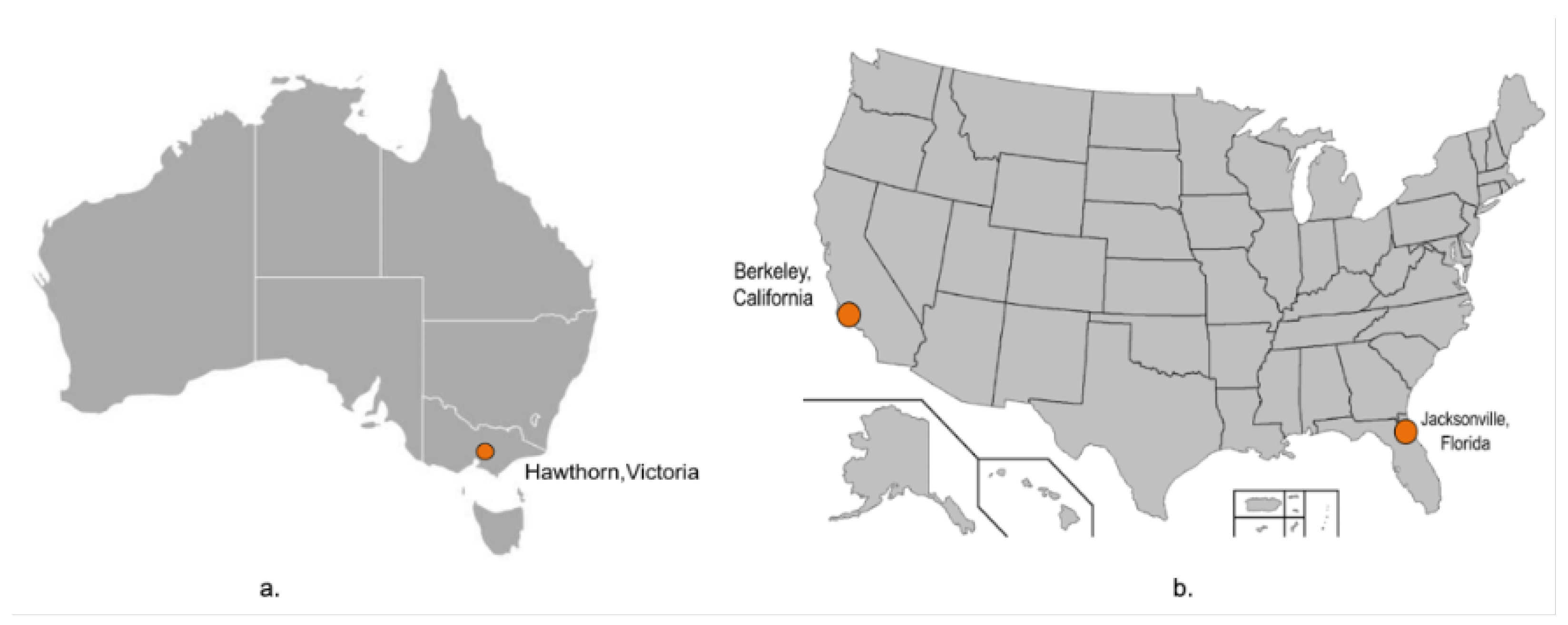

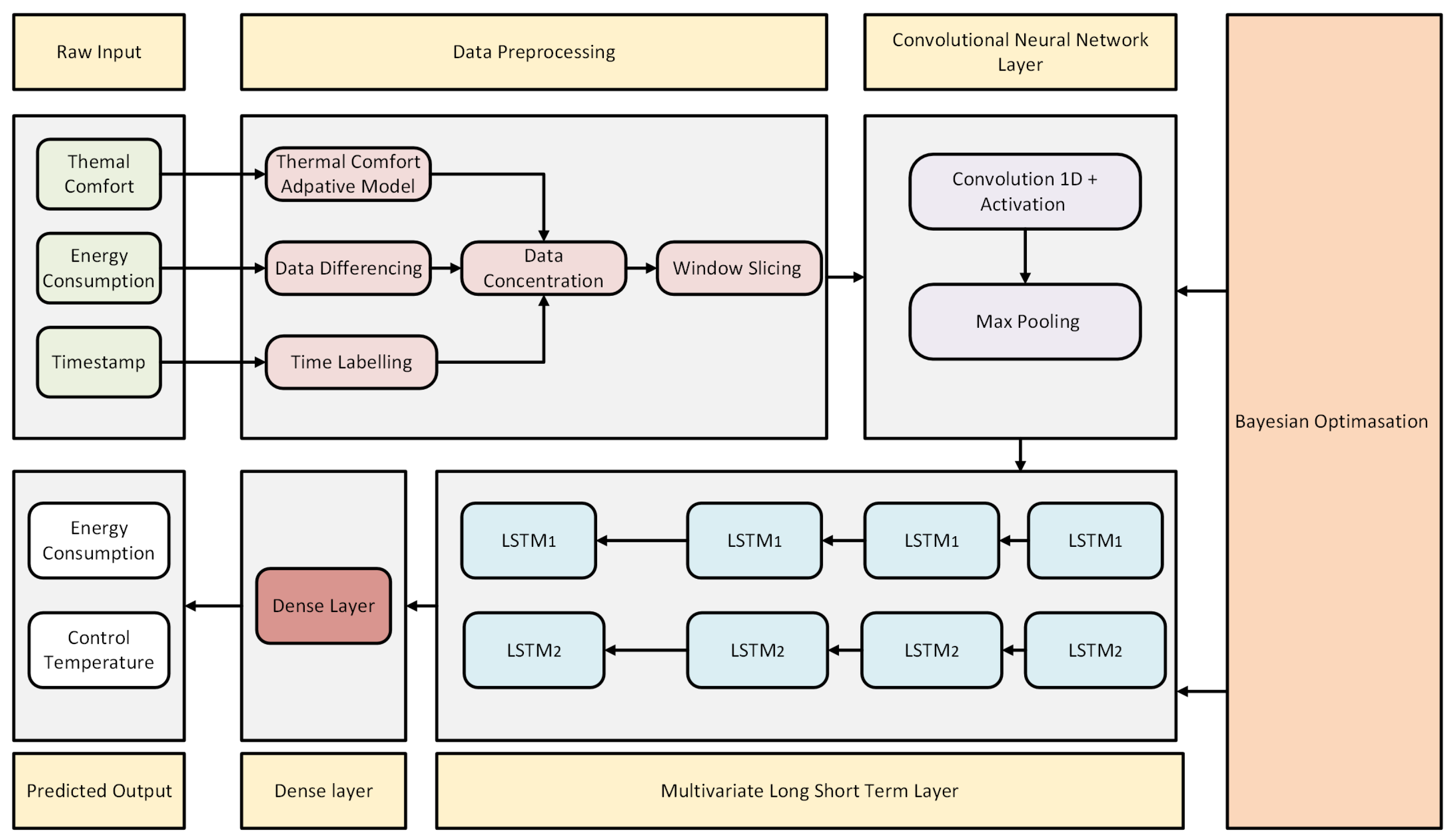
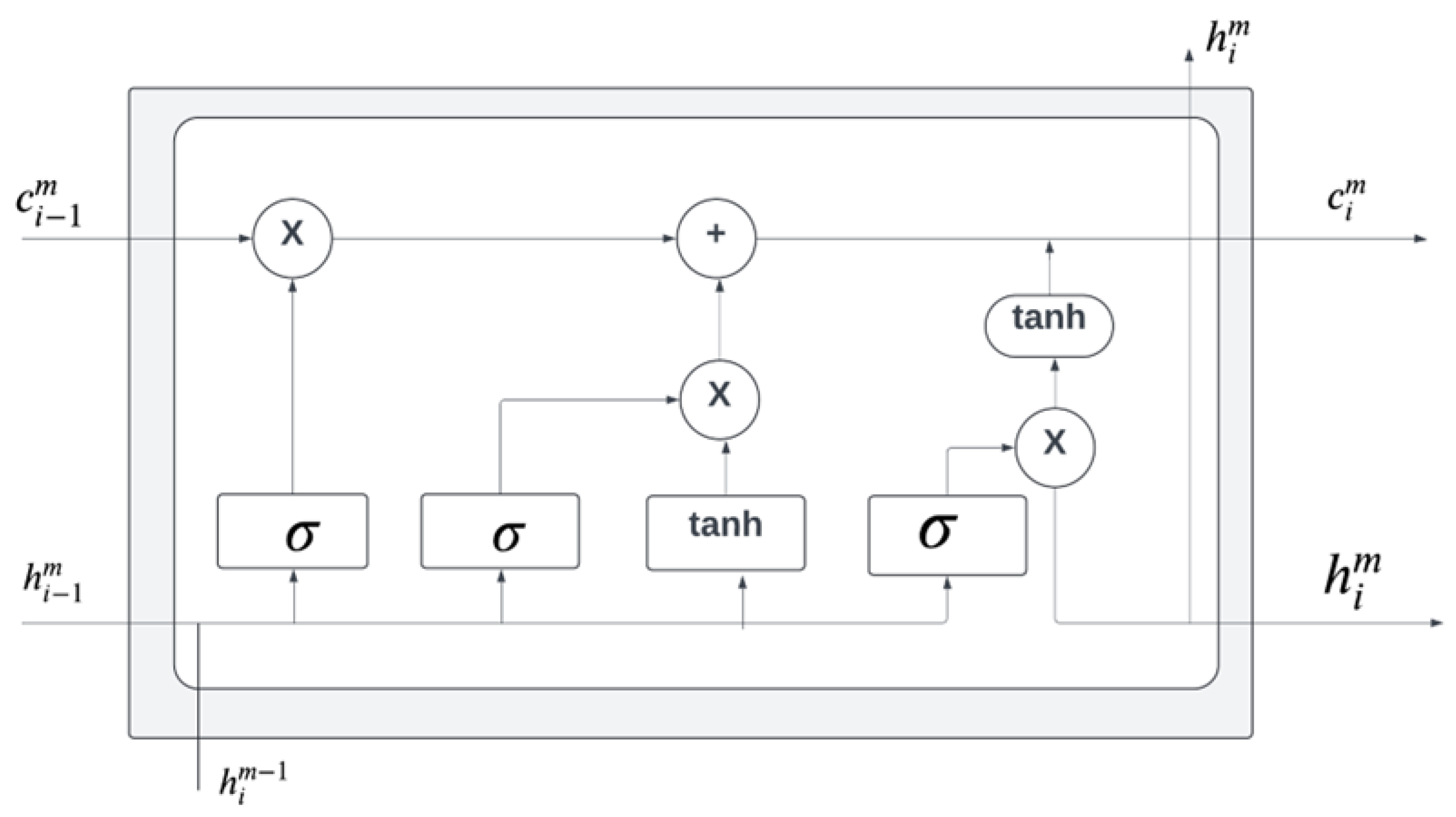
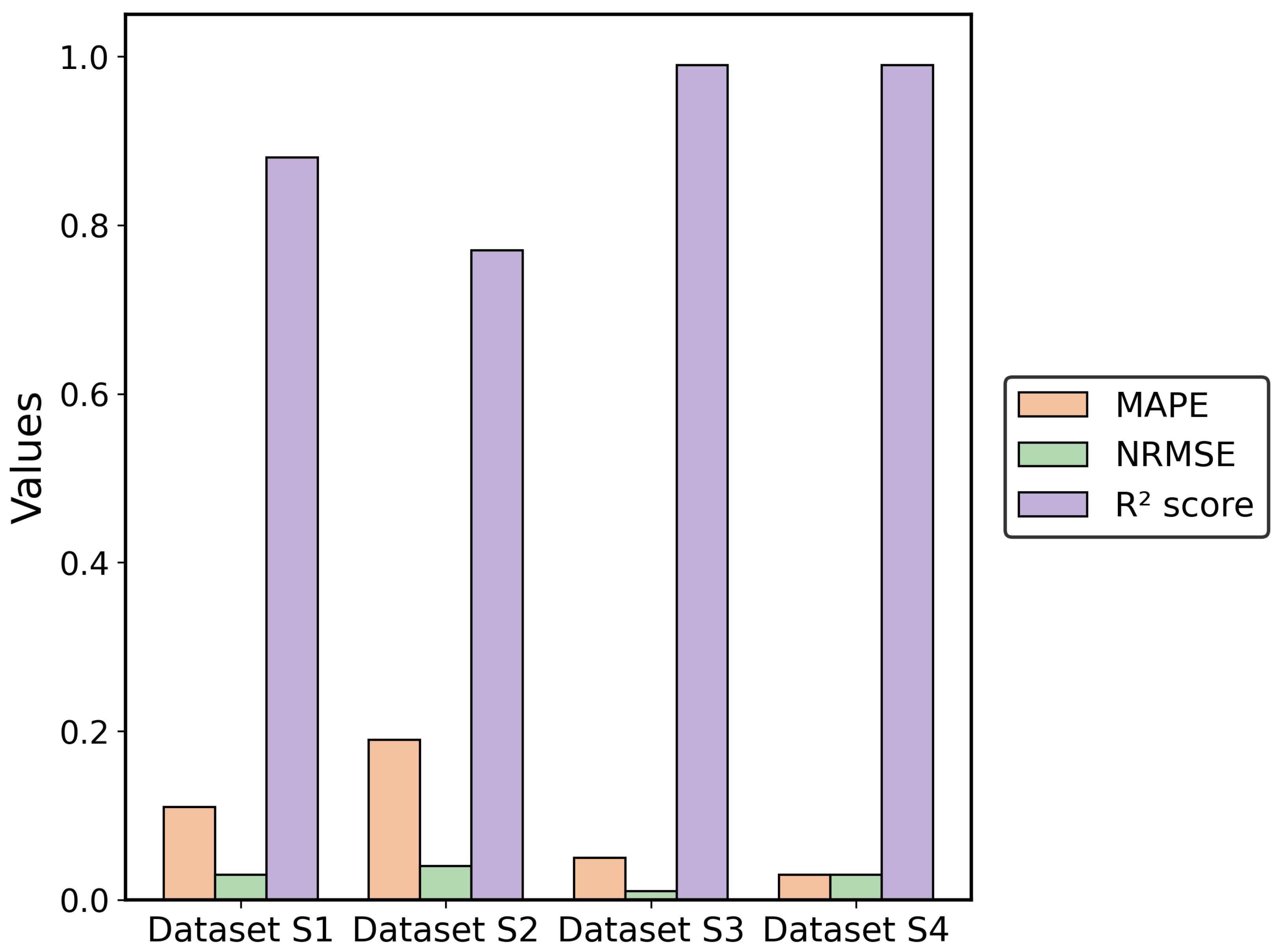

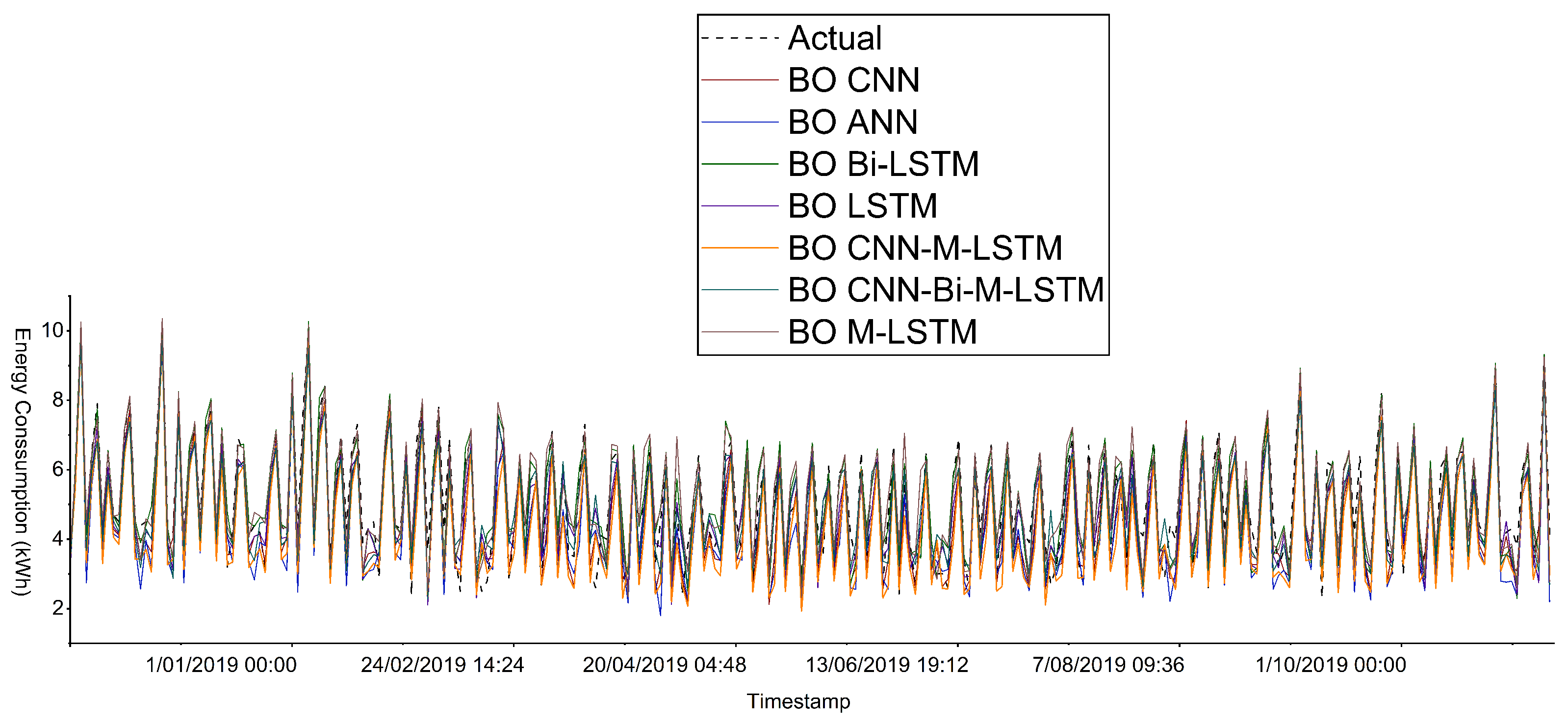


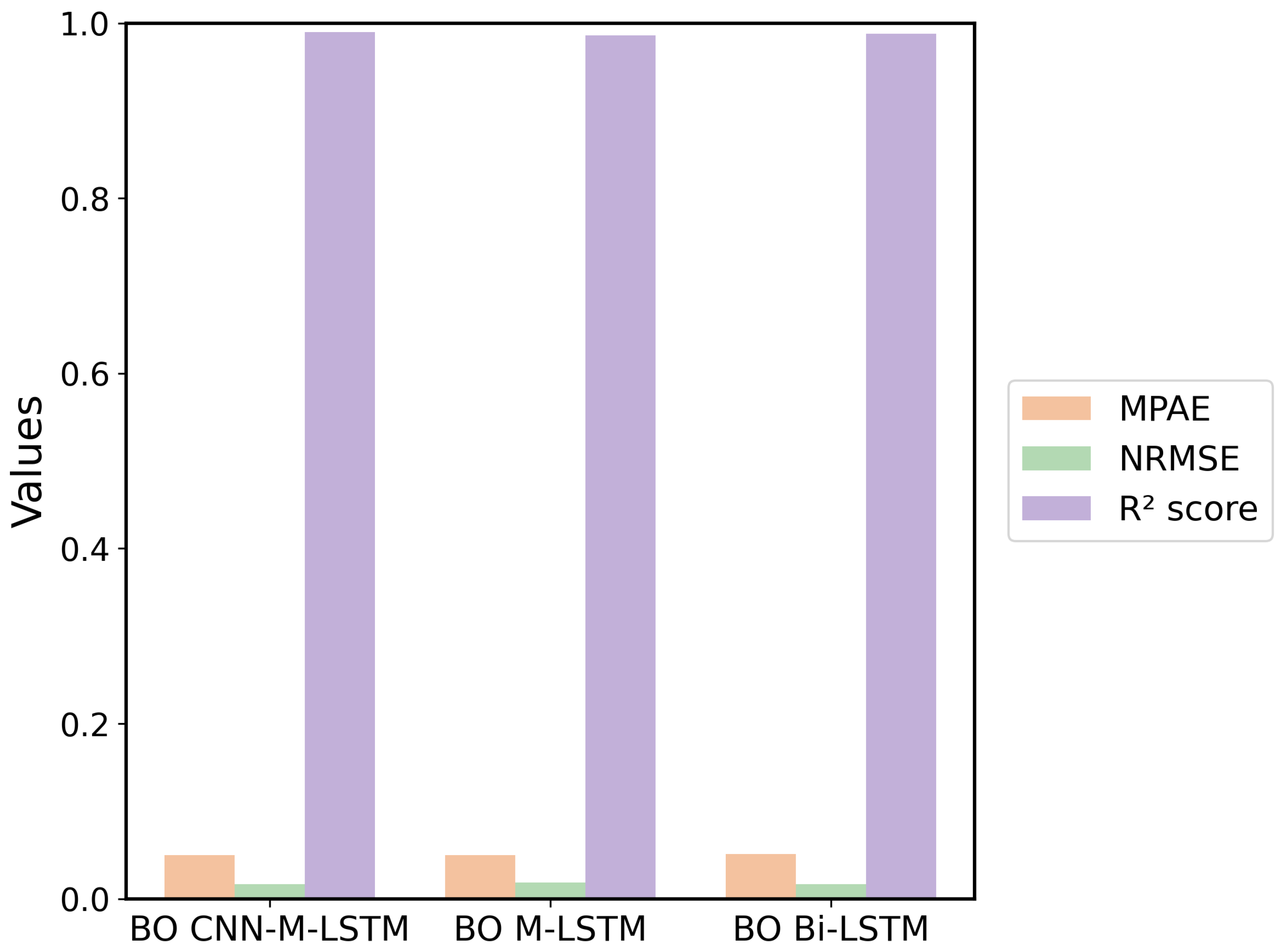

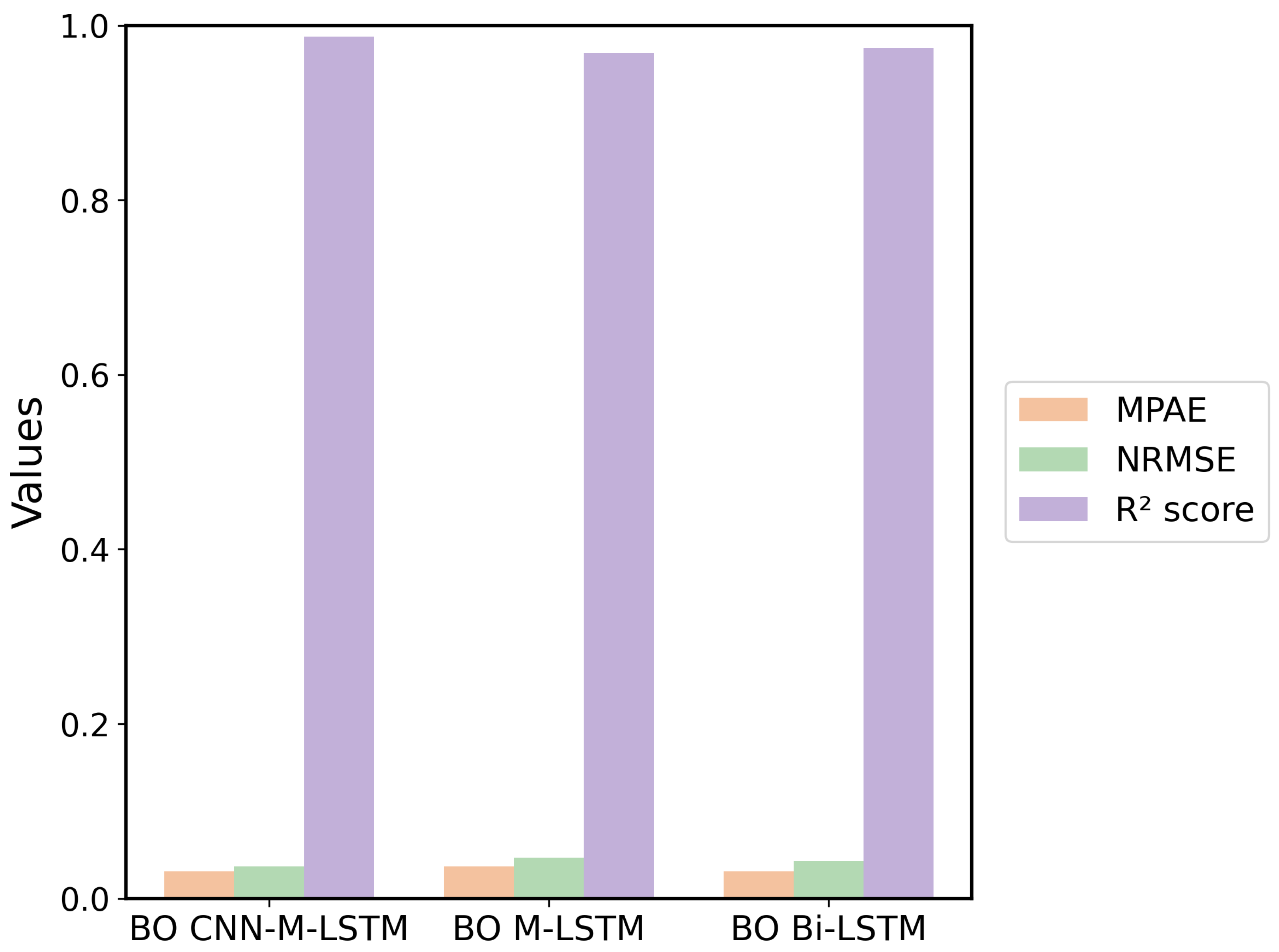
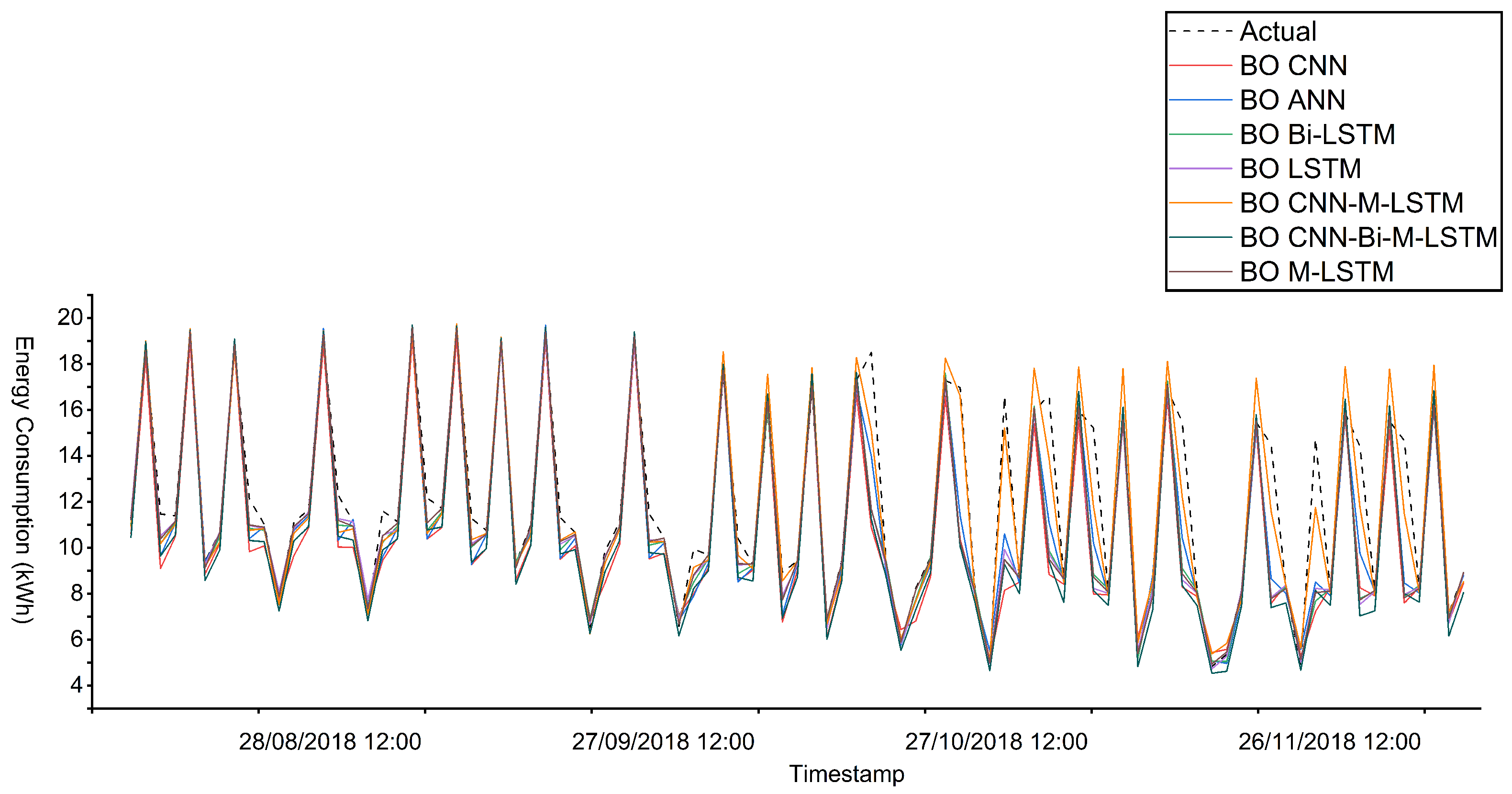
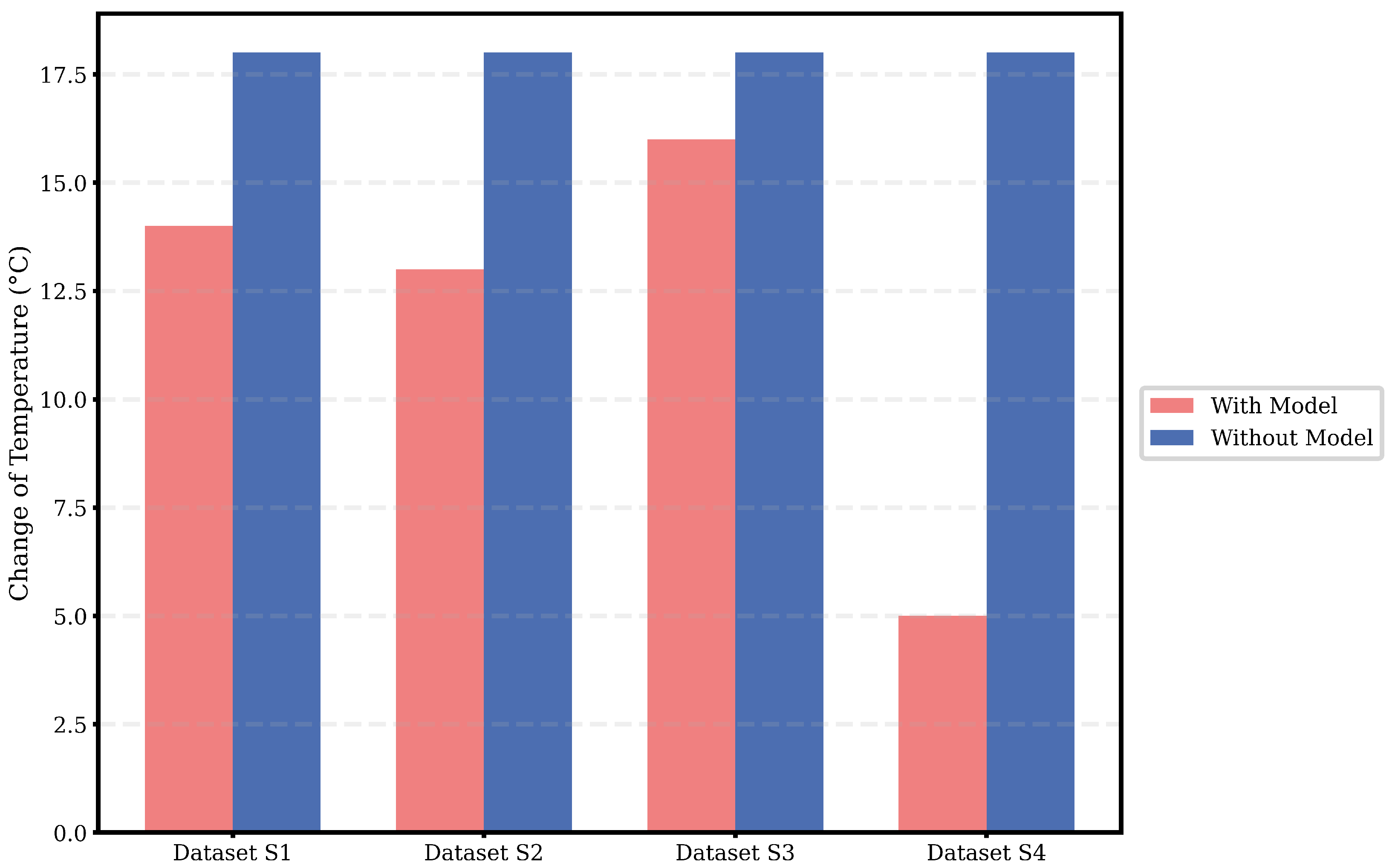
| ID | Forecasting Model | Year | Forecasting Horizon | RMSE | MAE | Score |
|---|---|---|---|---|---|---|
| 1 | SVM [11] | 2024 | 10 min ahead | 35,189 W | 25,653 W | 0.930 |
| 2 | ANN [11] | 2024 | 10 min ahead | 24,704 W | 18,081 W | 0.966 |
| 3 | XGBoost [11] | 2024 | 10 min ahead | 16,149 W | 11,354 W | 0.978 |
| 4 | LightGBM [11] | 2024 | 10 min ahead | 24,218 W | 15,827 W | 0.967 |
| 5 | DDPG [12] | 2019 | 5 min ahead | 19.092% | 3.858% | 0.992 |
| 6 | AE-DDPG [12] | 2019 | 5 min ahead | 15.321% | 3.470% | 0.992 |
| 7 | ED-LSTM with MP [13] | 2017 | 83 days ahead | 15.400% | ||
| 8 | ED-LSTM with SMP [13] | 2017 | 83 days ahead | 11.200% |
| Dataset | Model | Metrics | Metric Values | ||
|---|---|---|---|---|---|
| MPAE | NRMSE | Score | |||
| Dataset S1 | BO CNN-M-LSTM | 0.1163 | 0.0322 | 0.8676 | |
| BO CNN | 0.1259 | 0.0398 | 0.8551 | ||
| BO ANN | 0.1177 | 0.0365 | 0.8625 | ||
| BO M-LSTM | 0.1248 | 0.0408 | 0.8478 | ||
| BO LSTM | 0.1324 | 0.0429 | 0.8315 | ||
| BO CNN-Bi-M-LSTM | 0.1244 | 0.0404 | 0.8505 | ||
| BO Bi-LSTM | 0.1176 | 0.0388 | 0.8625 | ||
| Dataset S2 | BO CNN-M-LSTM | 0.1939 | 0.0385 | 0.7805 | |
| BO CNN | 0.2744 | 0.0427 | 0.7297 | ||
| BO ANN | 0.1964 | 0.0339 | 0.7788 | ||
| BO M-LSTM | 0.2052 | 0.0420 | 0.7376 | ||
| BO LSTM | 0.2256 | 0.0419 | 0.7388 | ||
| BO CNN-Bi-M-LSTM | 0.1946 | 0.0394 | 0.7692 | ||
| BO Bi-LSTM | 0.1964 | 0.0386 | 0.7788 | ||
| Dataset S3 | BO CNN-M-LSTM | 0.0499 | 0.0166 | 0.9896 | |
| BO CNN | 0.1002 | 0.0449 | 0.9221 | ||
| BO ANN | 0.0510 | 0.0232 | 0.9880 | ||
| BO M-LSTM | 0.0500 | 0.0189 | 0.9861 | ||
| BO LSTM | 0.0570 | 0.0245 | 0.9768 | ||
| BO CNN-Bi-M-LSTM | 0.0579 | 0.0224 | 0.9806 | ||
| BO Bi-LSTM | 0.0511 | 0.0170 | 0.9880 | ||
| Dataset S4 | BO CNN-M-LSTM | 0.0311 | 0.0370 | 0.9872 | |
| BO CNN | 0.0673 | 0.0536 | 0.9590 | ||
| BO ANN | 0.0313 | 0.0399 | 0.9739 | ||
| BO M-LSTM | 0.0371 | 0.0471 | 0.9684 | ||
| BO LSTM | 0.0390 | 0.0494 | 0.9652 | ||
| BO CNN-Bi-M-LSTM | 0.0399 | 0.0380 | 0.9794 | ||
| BO Bi-LSTM | 0.0313 | 0.0428 | 0.9739 | ||
| Average Energy Consumption (kWH) | Average Operating Cost ($) | |
|---|---|---|
| With Model | 6.24 | 1.63 |
| Without Model | 11.31 | 2.93 |
Disclaimer/Publisher’s Note: The statements, opinions and data contained in all publications are solely those of the individual author(s) and contributor(s) and not of MDPI and/or the editor(s). MDPI and/or the editor(s) disclaim responsibility for any injury to people or property resulting from any ideas, methods, instructions or products referred to in the content. |
© 2025 by the authors. Licensee MDPI, Basel, Switzerland. This article is an open access article distributed under the terms and conditions of the Creative Commons Attribution (CC BY) license (https://creativecommons.org/licenses/by/4.0/).
Share and Cite
Le, C.N.; Stojcevski, S.; Dinh, T.N.; Vinayagam, A.; Stojcevski, A.; Chandran, J. Bayesian Optimized of CNN-M-LSTM for Thermal Comfort Prediction and Load Forecasting in Commercial Buildings. Designs 2025, 9, 69. https://doi.org/10.3390/designs9030069
Le CN, Stojcevski S, Dinh TN, Vinayagam A, Stojcevski A, Chandran J. Bayesian Optimized of CNN-M-LSTM for Thermal Comfort Prediction and Load Forecasting in Commercial Buildings. Designs. 2025; 9(3):69. https://doi.org/10.3390/designs9030069
Chicago/Turabian StyleLe, Chi Nghiep, Stefan Stojcevski, Tan Ngoc Dinh, Arangarajan Vinayagam, Alex Stojcevski, and Jaideep Chandran. 2025. "Bayesian Optimized of CNN-M-LSTM for Thermal Comfort Prediction and Load Forecasting in Commercial Buildings" Designs 9, no. 3: 69. https://doi.org/10.3390/designs9030069
APA StyleLe, C. N., Stojcevski, S., Dinh, T. N., Vinayagam, A., Stojcevski, A., & Chandran, J. (2025). Bayesian Optimized of CNN-M-LSTM for Thermal Comfort Prediction and Load Forecasting in Commercial Buildings. Designs, 9(3), 69. https://doi.org/10.3390/designs9030069








